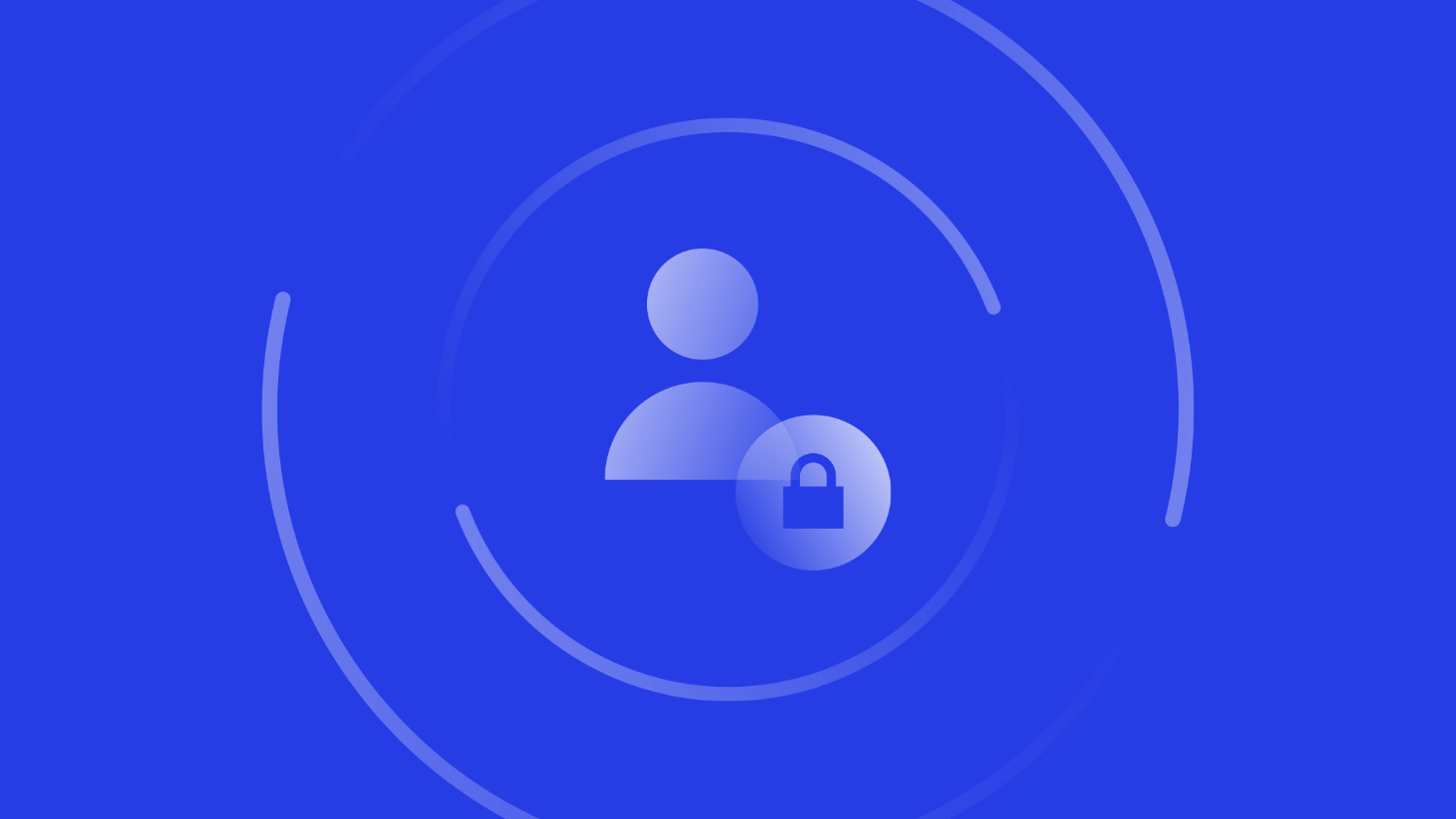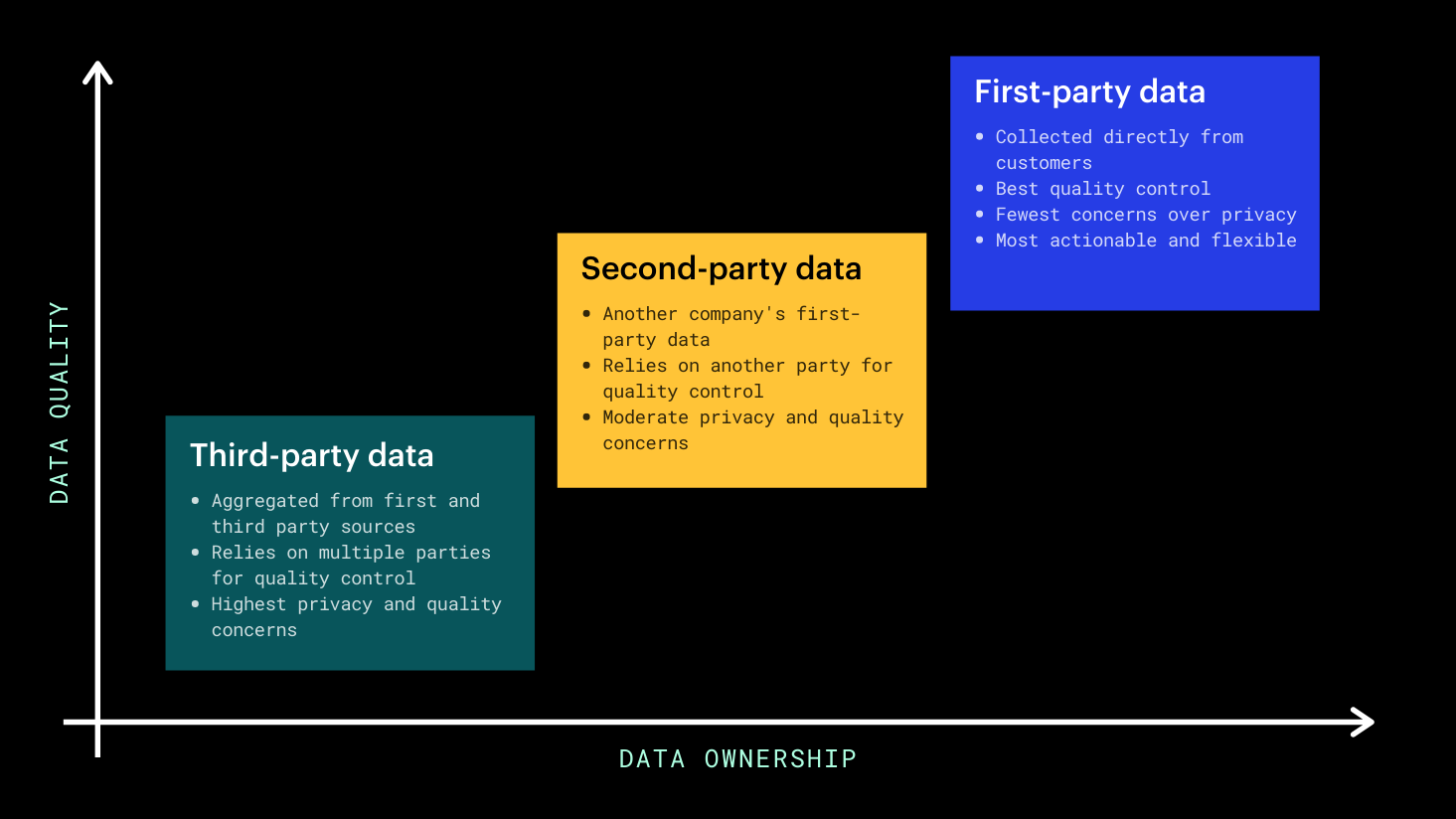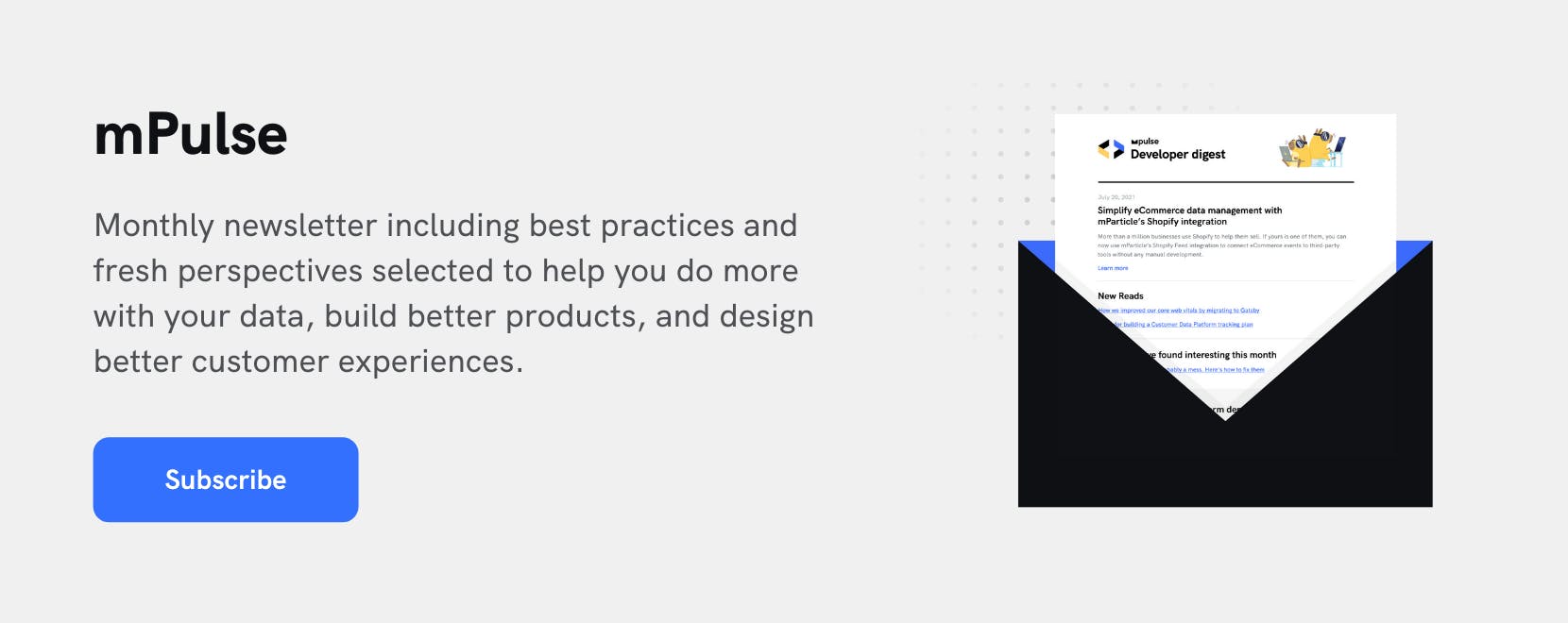What is first-party data?
First-party data is the most powerful and reliable type of customer information, and it can give your organization many distinct advantages. Learn how to distinguish between different categories of customer data, and the ways you can leverage your company’s first-party data from multiple channels.

First-party data is information that your customers provide directly to your organization through sources owned by your company. These sources could be online channels, like websites, apps, and interactions with digital paid ads, as well as offline channels, like point-of-sale and after-sale contact. Customers produce first-party data directly when they fill out forms on a website or create a user profile on an app, and indirectly when they make purchases, browse content, or take other actions on any of your company’s digital touchpoints.
Second-party data is another company’s first-party data that you can purchase to reach new audiences or augment information gathered directly from your customers. Large social and advertising networks, such as Facebook and Google, are major providers of second-party data. Finally, third-party data comprises both first- and second-party data that aggregation companies collect and sell to marketers. While second- and third-party data are typically not as reliable and accurate as data that your customers provide directly, they can still add value to your overall marketing strategy by helping you reach potential new customers.

What are the differences between first, second, and third-party data?
The unique value of first-party data
Ownership is the key factor that differentiates categories of customer data. Since first-party data is information that your customers provide directly to your organization, your company has complete ownership over it. It is the easiest to manage and store, and you can have a much higher degree of confidence in its accuracy and relevance than data from other sources. Additionally, privacy concerns around first-party data are minimal, since you know exactly how it was collected, and what privacy agreements customers consented to when providing it.
For these reasons, first-party data is an extremely powerful tool for marketers. It can be used to predict future customer behavior patterns, gain insights into your current customers, and create audience segments. As our digital lives become more connected each year, it’s increasingly clear that customers expect relevant offers and communication from brands. To this point, a recent study by Forrester revealed that “Nearly three-fourths (74%) of online consumers get frustrated with websites when content (e.g., offers, ads, promotions) that has nothing to do with their interests,” and other insights revealing that it is critical for brands to deliver personalized experiences. First-party data’s potential to help companies personalize customer interactions is perhaps the most compelling reason to get serious about how you collect and use these invaluable insights from your customers.
Here are some specific areas in which first-party data can help you ensure that your customer interactions deliver maximum value for both your company and your customers:
Personalizing customer interactions
Accurate and timely data provided by your customers can inform new ways to personalize customer experiences and tailor messaging. Armed with insights about your customers’ behavior and preferences from across your digital properties, your marketing team will be able to use data points like purchase history, location, and specific interests to craft interactions tailored to your individual customers. This not only increases the chances of conversion at every step in the customer journey, but elevates the customer experience to the level of relevance and personalization that today’s consumers expect from brands.
Cross-channel measurement
By connecting data on individual customers from all of your touchpoints, you have the benefit of seeing real people move from opening an email to visiting a website to downloading an app to making and repeating purchases. These insights will allow you to more accurately pinpoint parts of the customer journey that see the most dropoff, and single these areas out to test and implement improvements in the customer experience. Gone are the days of being confined to a hazy view of your customers pieced together from less accurate, less personal, and less relevant data sources. With such a complete and detailed view of the customer journey, you can more easily segment audiences and guide customers down paths that are more likely to lead to conversion and retention.
Optimizing paid campaigns
Google is increasingly putting PPC accounts into the hands of automated systems with the use of technologies like Smart Bidding. By populating these systems with reliable and current first-party data directly from your customers before you launch your campaigns, you will be able to set more accurate target audiences and informed bidding strategies in your PPC efforts. First-party data also allows you to conduct more accurate post-campaign analysis to refine your targeting and bidding strategies for future PPC activity. For example, once you acquire customers through your paid campaigns, you can compare long term first-party data from customers converted from different audiences to see which of these segments delivers the highest overall value for your company, and allocate your spending accordingly.
Behavioral analytics queries
By capturing the event data that users generate when they navigate through your sites and apps––and tying this information to specific individuals in persistent user profiles–– you’re building a treasure trove of information. Teams can look at this data holistically to discover which features and content users find most relevant, or create user segments to uncover insights based on age, gender, geographic location and other demographic information. With a robust set of first-party data, your teams can perform behavioral analytics queries to see how feature changes are impacting user behavior, where customers are getting stuck, and how you can optimize your sites and apps for easier customer journeys and higher conversion rates.
Building quality relationships with existing customers
Nurturing relationships with your existing customers is without a doubt one of the most powerful ways to leverage first-party data. According to a plethora of marketing industry insights, keeping the customers you already have––and ideally, turning them into rabid evangelists for your brand––is a more valuable way to spend your time and resources than trying to acquire new customers. Citing a study by Bain & Company, Frederick F. Reichheld and Phil Schefter of the HBR noted that increasing customer retention rates by 5% increases profits by 25% to 95%, while the high cost of acquiring new customers may render these relationships unprofitable for years. First-party data is the story that each of your existing customers tells you about their preferences and interests every time they interact with one of your websites or apps. Collecting this data effectively, and having a plan for how to use it once you own it, is key to building these meaningful and lasting relationships with your customers.
Challenges in activating first-party data
Effectively collecting customer data––which itself involves extensive planning by marketers and product managers, and many implementation hours from developers––is a significant hurdle, but this is only half the battle. Once first-party data is collected, each customer’s information must then be integrated across platforms and filtered into a single view in order to see a complete picture of that individual. Your team must also have a way of ensuring that the data that is collected from customers meets quality and consistency standards before it is moved downstream, which is another major challenge demanding close cross-team collaboration.
Although linking first-party data from online and offline sources into a complete view of your customers is a challenge, it is one that can pay major dividends in the end. According to a global digital marketing survey conducted by Boston Consulting Group, “companies that link all of their first-party data sources can generate double the incremental revenue from a single ad placement, communication, or outreach, and 1.5 times the improvement in cost efficiency over companies with limited data integration.”
Unify your first-party data to unlock its full potential
Customer Data Platforms (CDPs) are a unique and powerful solution to this problem of integration, among many other data challenges that organizations face. Learn more about what differentiates a CDP from other data solutions in terms of leveraging first-party data, and find out how your team can benefit from making a CDP the cornerstone of your marketing stack.




